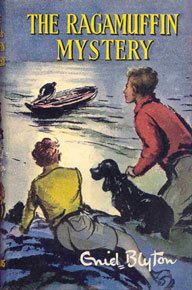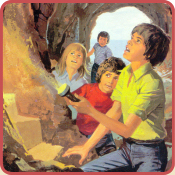
The Ragamuffin Mystery

Book Details...
First edition: 1959
Publisher: William Collins
Illustrator: Gilbert Dunlop
Category: Barney Mystery Series
Genre: Mystery/Adventure
Type: Novels/Novelettes
Publisher: William Collins
Illustrator: Gilbert Dunlop
Category: Barney Mystery Series
Genre: Mystery/Adventure
Type: Novels/Novelettes
On This Page...
Reprints
1. 1973 Armada, illustrations by Gilbert Dunlop, cover uncredited
2. 1979 Armada, illustrations by Gilbert Dunlop, cover by Peter Archer
3. 1986 Armada, illustrations by Gilbert Dunlop, cover uncredited
4. 1990 Armada, illustrations by Gilbert Dunlop, cover uncredited
5. 1993 Armada, not illustrated, cover uncredited
6. 1997 Collins, not illustrated, cover by Piers Sanford
7. 2003 Award, illustrations and cover by Eric Rowe
2. 1979 Armada, illustrations by Gilbert Dunlop, cover by Peter Archer
3. 1986 Armada, illustrations by Gilbert Dunlop, cover uncredited
4. 1990 Armada, illustrations by Gilbert Dunlop, cover uncredited
5. 1993 Armada, not illustrated, cover uncredited
6. 1997 Collins, not illustrated, cover by Piers Sanford
7. 2003 Award, illustrations and cover by Eric Rowe

Wraparound dustwrapper from the 1st edition, illustrated by Gilbert Dunlop

Frontis from the 1st edition, illustrated by Gilbert Dunlop

1st German edition published by Blüchert Verlag in 1962,
illustrated by Nikolaus Plump with the title Riddle of the Forbidden Cave
Although this is the final book in the original series, there were two further books in German.
The Mystery That Never Was was turned in to No.7 and a 'ghost' book with no English Translation was No.8. This can be found under Continuation Books.
German: Rätsel um die verbotene Höhle
French: Le Mystère Des Voleurs Voles
Dutch: Robbert Jan en het geheimzinnige hotel
Spanish: Misterio del Vagabundo
Portuguese: O MIstério do Maltrapilho
Danish: Feriebanden og det mystiske kodebrev
Latvian: Noslepumainais
Icelandic: Radgatan I sveitakranni
Slovakian: Skrivnost prepovedane Votline
Brief Summary by Robert Houghton: When Roger, Diana, Snubby and Barney, along with Miranda the monkey and Loony the spaniel, go to stay at Penrhyndendraith Inn, in Wales with Miss Pepper, they immediately fall into another thrilling adventure. It all begins when Snubby buys some second-hand clothes and is mistaken for someone else. The secret message he is given soon sets the children on to the trail of a dangerous gang – but what are they up to in the sleepy seaside village and the nearby Merlin's Cove?
Full Review (This may contain spoilers):
Anita Bensoussane's Review
In The Ragamuffin Mystery, Blyton gives us a run-of-the-mill adventure story reminiscent of the Famous Five. Roger and Diana set off on a caravanning holiday with their mother and Miss Pepper but their trip is spoilt when Mrs. Lynton is called away to care for her sister, Auntie Pat, who has injured herself in a fall from a ladder. Luckily, Barney saves the day by turning up with his father, who arranges for Roger, Diana, Barney and Miss Pepper to have a holiday at an inn in Penrhyndendraith, a fishing-village on the Welsh coast. Snubby joins them, as he had been staying with Auntie Pat.
The inn is kept by a Mr. and Mrs. Jones whose unruly son, a little boy named Dafydd, has a pet goose, Waddle. Mr. Llewellyn Jones is a surly, taciturn man but is famous for his "very good cooking," as his talkative wife is fond of telling people. Llewellyn's mother, known as "old Mrs. Jones," has a general store in the village, and she too repeatedly praises her son's "Cooking good, very good cooking!"
Surprisingly, Mr. and Mrs. Jones are reluctant to give Miss Pepper and Diana the room they want but Miss Pepper insists, refusing to be put off by tales of "noises in the night." The boys are to sleep in the caravan next to the inn.
Having managed to get two sets of clothes filthy in just one day, Snubby buys some brightly-coloured but ragged second-hand clothes from old Mrs. Jones. These make him look like a "ragamuffin" and lead to his being mistaken for the son of a fisherman. As a result, someone hands him a letter giving details of planned criminal activity. Snubby and the others cannot read the letter because it is in code but they are plunged nevertheless into yet another adventure — an adventure which culminates in the discovery that stolen bank-notes are being brought to the area at night by boat and stored down a rocky passage, to be used at a later date. Two of the criminals are staying at the inn, posing as the well-known botanist and ornithologist, Sir Richard Ballinor and Professor Hallinan. The two men have Mr. Jones in their power as they lent him the money to buy the inn. In return, he agreed to co-operate with them and allow them to use the rocky passage leading from the beach to the bedroom in which Diana and Miss Pepper sleep.
Suspicious of the so-called ornithologist, Professor Hallinan, Barney and Diana question him about fictitious birds in order to catch him out. I was intrigued to see the same ploy used by Malcolm Saville in The Thin Grey Man (1966). He too has one of his child characters question a supposed bird-watcher about fictitious birds, exposing the man as a fraud.
At the end of the book, Mr. Jones and his two "friends" are taken away by the police but his wife stands up for him and we are left with the impression that she will stick by him and make sure that he leads an honest life in the future. She says: "He's not bad is my Llewellyn, not wicked at all. It was those men, with their lies and their promises. They tempted my poor Llewellyn, they lent him money to buy the inn."
The Ragamuffin Mystery is a disappointing end to the series, lacking the twists and turns of earlier titles. I've never really seen the point of all that waffle at the start concerning the caravan holiday that never was — except that it serves to pad out a woefully thin story-line!
Several things strike me as odd. Diana says, in Chapter 1, "Fancy dad buying a caravan!" Yes, fancy that! It seems out of character. We have seen that Mr. Lynton is incapable of coping with the children for very long even in a house, and I cannot imagine him enjoying being cooped up in a caravan with his family. Unbelievably, Diana adds, "Daddy's such fun on holiday!" Is he? That's news to me! In previous books he has come across as irritable, impatient, unreasonable and humourless. He is anything but a bundle of laughs at home and spends as little time as possible with the children when they're on holiday from school. And, when it comes to the crunch, this holiday is no exception. Although he had intended to come on the caravan holiday with his family, Mr. Lynton lets them down at the last minute and jets off to America as usual (we recall that both he and Mrs. Lynton went off to America at the beginning of The Rockingdown Mystery and The Rubadub Mystery.) Once again, the contrast between Mr. Lynton and Mr. Martin is marked. Mr. Martin and Barney have just spent a week travelling around together.
We were told in The Rockingdown Mystery that Roger was "mad on nature" but there is no evidence of that during the rest of the series and, in this book, Roger not only shows no interest when old Mrs. Jones says that there are rare birds and flowers in Penrhyndendraith, but he groans whenever Diana mentions the essay she has to write on "Birds I Have Seen."
Blyton reuses a number of ideas from earlier in the series. There are "noises in the night," as there are in so many of the books, and the inn at Penrhyndendraith is "a strange old place with curious turrets and towers," just like Rat-a-Tat House which was "rather odd looking," with "turrets and towers." Diana is astonished at old Mrs. Jones' shop, remarking that it "must sell simply everything in the world!...Eatables, drinkables, china, pots and pans, fishing-nets, pails, potatoes, spades, stools — goodness, Miss Pepper, it's like a shop out of an old fairy-tale!" It's funny that she should be so surprised, since there were similar shops at Rockingdown and Ring O' Bells! When old Mrs. Jones appears, Roger whispers to Diana, "And here's the witch!" Blyton often describes old women as witches — Old Ma in The Rilloby Fair Mystery and Naomi Barlow in The Ring O' Bells Mystery spring to mind. Then there is Snubby's having to go to great lengths to avoid the two men posing as Sir Richard Ballinor and Professor Hallinan (because they might recognise him as the boy who received the code-letter), just as he had to avoid Great-uncle Robert in The Rilloby Fair Mystery.
Another familiar ingredient is the confusion over trains. In The Rockingdown Mystery, Roger and Diana went to meet Snubby's train only to find that he had got off the train when it was delayed, and taken the bus instead. The Rilloby Fair Mystery saw Snubby and Great-uncle Robert alighting at different stations en route to the Lyntons' house, each thinking that his chosen station was the nearer. In The Ragamuffin Mystery, the others are preparing to meet Snubby at the station in Dilcarmock when he arrives at the inn by himself, having caught an earlier train and then hitched a lift to Penrhyndendraith in a cart.
There are shades of other series as well, especially the Famous Five. Dafydd the Welsh boy refers to the rocky passage as a "long hole" while, in Five Get Into a Fix (published in 1958, only a year before The Ragamuffin Mystery), Aily the Welsh girl refers to a rocky passage as a "big big hole." Dafydd and Aily run wild and are sure-footed like goats, even in the dark. Both have "eyes like a cat." Tassie, in The Castle of Adventure (1946), is another child of Celtic origin — Scottish, this time — who roams the hills and mountains like a sprite or a pixie, at one with nature.
Mr. Jones resembles Mr. Andrews, the farmer in Five Go Off to Camp. Both men allow their properties to be used by criminals in return for financial reward but Blyton portrays them merely as weak characters who succumbed to temptation, rather than as evil men. They allowed themselves to be led astray by others but were burdened with guilt, causing them to be unhappy and sullen. In both cases, the implication is that their wives will support them on their release from prison and keep them on the straight and narrow.
It is the complex character of Mr. Jones which adds depth to The Ragamuffin Mystery. When old Mrs. Jones tells Snubby that Llewellyn's friends in London lent him the money to buy the inn — on which he had set his heart ever since he was a child — she adds, "How happy my Llewellyn is now!" Snubby is surprised: "Snubby thought of the cross-looking, dour man he had seen the night before. 'Goodness — he doesn't look very happy!' he said." There is more to it than Snubby realises. Llewellyn has gained his heart's desire — the inn — but at a price. In return he has to allow it to be used for criminal activity and this troubles him, making him bad-tempered and irritable even though, on the surface, he has every reason to be content.
An unwelcome development in The Ragamuffin Mystery is the change in Barney. No longer a vagrant or a circus-boy, he joins in with Miss Pepper and the others in calling Snubby "a real tramp" in his second-hand clothes, and even refers to Dai, the fisher-boy, as "a regular ragamuffin." We'd expect a greater degree of sensitivity from a boy who once introduced himself as "just tramping around," but Barney is becoming integrated, perhaps inevitably, into the "normal" society of the time, sadly losing some of his individuality and his allure in the process.
Barney says of Dafydd, who runs wild, "Funny little chap — he went up the rocky cave-wall like a monkey — well, like Miranda did actually — with a spring and a leap and a jump! He must have eyes like a cat — I believe he would be able to see in the darkness of that passage." It's not so long ago that Barney himself was described in such terms — as a fearless, daring and agile acrobat, trusting to instinct as well as intelligence. In several of the earlier books, he was said to be "like a cat." Yet in this book he is more cautious and, when Snubby proposes exploring caves labelled "DANGEROUS," Barney says firmly, "Any fatheadedness on your part, and you go straight back to another of your uncles and aunts."
As far as writing style is concerned, there is nothing in The Ragamuffin Mystery to match the wonderful rhythms and imagery of The Rubadub Mystery. However, there are some brief pieces of descriptive writing, such as when Enid Blyton describes the children's journey along the coast to Penrhyndendraith: "Ah, now they were leaving behind the crowded part of the coast, and coming to deserted bays, lonely sweeps of sand, tiny villages, fishing hamlets." Talk about conjuring up a vast picture in a handful of carefully chosen words! Penrhyndendraith itself is described memorably but succinctly too — "a fishing village, with a dozen or so old cottages built along the seafront and others straggling up the slope of the hill behind." As the children are driven up to the inn, they have a view of "the great stretch of heaving sea" and of mountains which are "a blaze of heather." It is evocative words like "sweeps," "straggling," "heaving" and "blaze," and the lilting quality of the prose, which help to convey so much in just a few lines.
The Ragamuffin Mystery contains several words which are unusual for Blyton — "ensconced," "interspersed" and "surmised" — as well as Blyton's favourite 'long word' — "ornithologist"! Oh, and "dilapidated" is obviously her 'new word,' since she uses it to describe not only the dining-room at the inn, but Snubby's second-hand trousers!
A couple of trite sayings have crept into this book, for example when Mrs. Lynton is called away to Auntie Pat, and Miss Pepper remarks, "Things like this do happen, you know — and then we often find out how strong — or weak — we are!" And, when Roger and Diana receive a telegram from Barney, Blyton writes: "How good it was to have friends — how very very good!" Platitudes like these crop up with increasing regularity in Blyton's later books, sometimes to a wearing degree, as in The Mystery of Banshee Towers (1961), where Fatty's continual preaching to Ern about friendship is quite nauseating.
The idea of Snubby exchanging letters in code with his friend, Bruce, is convincing. Anything to do with secrets or puzzles would appeal to a boy like Snubby, who has a lively imagination. In Enid Blyton — The Biography (1974), Barbara Stoney mentions that, as a schoolgirl, Enid herself used to correspond in code with two of her friends, Mirabel Davis and Mary Attenborough. A copy of one of Enid's letters to Mirabel, dated 1913, is reproduced in Chapter 1 of Barbara Stoney's book. It was Michael Rouse, Editor of the much-missed Green Hedges Magazine, who pointed out to me that, in her letter to Mirabel, Enid Blyton was using a cipher which appears in Volume 1 of Arthur Mee's The Children's Encyclopedia. I have a set of The Children's Encyclopedia dating from about 1950 and I read all ten volumes voraciously as a child, loving the inspiring essays, stories and projects they contained. I was delighted to read, in Barbara Stoney's biography, that Enid Blyton loved Arthur Mee's encyclopedias too. These illustrations are hidden by default to ensure faster browsing. Loading the illustrations is recommended for high-speed internet users only.








